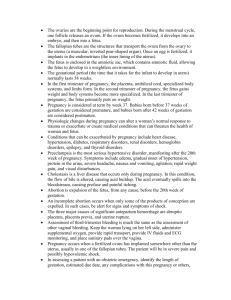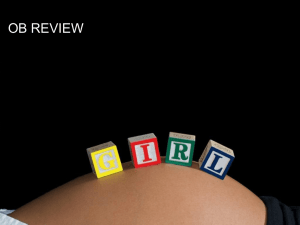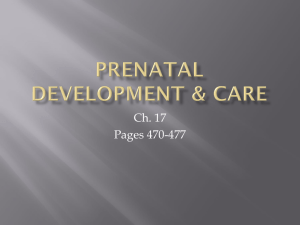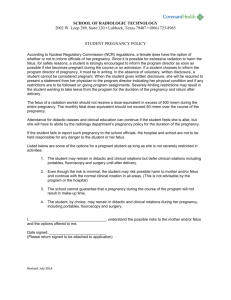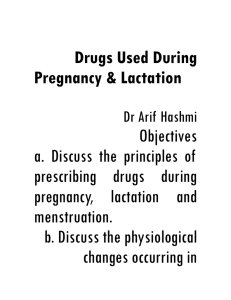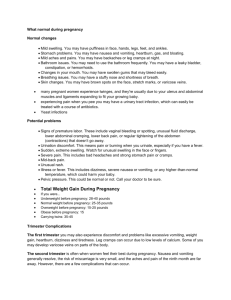Chapter 41: Obstetrics - Paramedic.EMSzone.com
advertisement
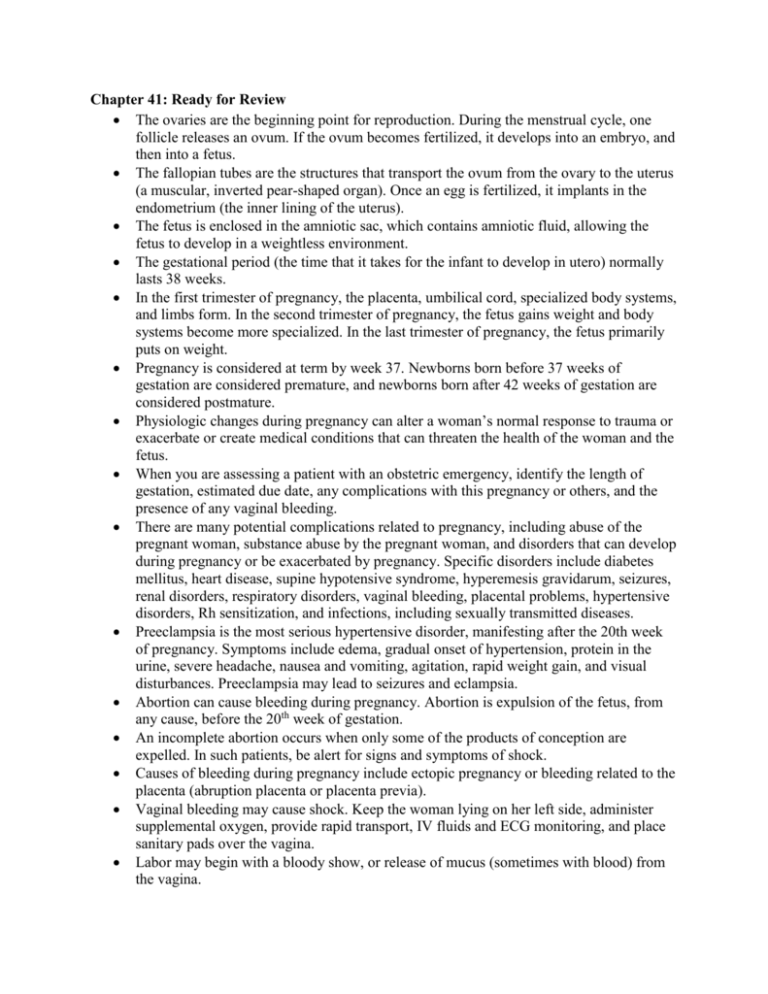
Chapter 41: Ready for Review The ovaries are the beginning point for reproduction. During the menstrual cycle, one follicle releases an ovum. If the ovum becomes fertilized, it develops into an embryo, and then into a fetus. The fallopian tubes are the structures that transport the ovum from the ovary to the uterus (a muscular, inverted pear-shaped organ). Once an egg is fertilized, it implants in the endometrium (the inner lining of the uterus). The fetus is enclosed in the amniotic sac, which contains amniotic fluid, allowing the fetus to develop in a weightless environment. The gestational period (the time that it takes for the infant to develop in utero) normally lasts 38 weeks. In the first trimester of pregnancy, the placenta, umbilical cord, specialized body systems, and limbs form. In the second trimester of pregnancy, the fetus gains weight and body systems become more specialized. In the last trimester of pregnancy, the fetus primarily puts on weight. Pregnancy is considered at term by week 37. Newborns born before 37 weeks of gestation are considered premature, and newborns born after 42 weeks of gestation are considered postmature. Physiologic changes during pregnancy can alter a woman’s normal response to trauma or exacerbate or create medical conditions that can threaten the health of the woman and the fetus. When you are assessing a patient with an obstetric emergency, identify the length of gestation, estimated due date, any complications with this pregnancy or others, and the presence of any vaginal bleeding. There are many potential complications related to pregnancy, including abuse of the pregnant woman, substance abuse by the pregnant woman, and disorders that can develop during pregnancy or be exacerbated by pregnancy. Specific disorders include diabetes mellitus, heart disease, supine hypotensive syndrome, hyperemesis gravidarum, seizures, renal disorders, respiratory disorders, vaginal bleeding, placental problems, hypertensive disorders, Rh sensitization, and infections, including sexually transmitted diseases. Preeclampsia is the most serious hypertensive disorder, manifesting after the 20th week of pregnancy. Symptoms include edema, gradual onset of hypertension, protein in the urine, severe headache, nausea and vomiting, agitation, rapid weight gain, and visual disturbances. Preeclampsia may lead to seizures and eclampsia. Abortion can cause bleeding during pregnancy. Abortion is expulsion of the fetus, from any cause, before the 20th week of gestation. An incomplete abortion occurs when only some of the products of conception are expelled. In such patients, be alert for signs and symptoms of shock. Causes of bleeding during pregnancy include ectopic pregnancy or bleeding related to the placenta (abruption placenta or placenta previa). Vaginal bleeding may cause shock. Keep the woman lying on her left side, administer supplemental oxygen, provide rapid transport, IV fluids and ECG monitoring, and place sanitary pads over the vagina. Labor may begin with a bloody show, or release of mucus (sometimes with blood) from the vagina. The first stage of labor begins with the onset of contractions— crampy abdominal pains that may radiate into the lower back. The amniotic sac may also rupture. The second stage of labor begins when the fetus’s head enters the birth canal. The woman’s contractions become more intense and more frequent. When the head becomes visible at the vaginal opening (crowning), delivery is imminent. The third stage of labor occurs when the placenta is expelled. When you are assessing a pregnant patient, determine whether there is time to provide transport to the hospital. If delivery is imminent, quickly prepare a private clean area. Behave in a calm and reassuring way. Control the delivery. Clear the newborn’s airway. Never pull on the umbilical cord to deliver the placenta. Gently massage the abdomen to aid in delivery of the placenta. Pharmacology during pregnancy may include magnesium sulfate for eclampsia, calcium chloride to reverse respiratory depression following magnesium sulfate administration; terbutaline for asthma and as a uterine relaxant and occasionally for cord prolapse, diphenhydramine for treating hyperemesis gravidarum, and oxytocin for treatment of postpartum hemorrhage. Complications related to high-risk pregnancy include precipitous labor and birth, postterm pregnancy, meconium staining, fetal macrosomia, multiple gestation, intrauterine fetal death, amniotic fluid embolism, hydramnios, and cephalopelvic disproportion. Meconium is the fetus’s first stool. A yellow or greenish black tint to the amniotic fluid indicates the presence of meconium. Vigilantly suction the newborn if meconium staining is present and the newborn is depressed (not vigorous). Complications of labor include premature rupture of membranes, preterm labor, uterine rupture, and fetal distress. Complications of delivery include cephalic presentation, breech presentation, shoulder dystocia, nuchal cord, and prolapsed cord. Postpartum complications include uterine inversion, postpartum hemorrhage, pulmonary embolism, and postpartum depression. In the case of postpartum hemorrhage, massage the abdomen, provide IV fluid resuscitation, and transport urgently. Pulmonary embolism can cause maternal death during childbirth or postpartum. Suspect this complication if the patient experiences sudden dyspnea, tachycardia, atrial fibrillation, or postpartum hypotension. The major causes of injury to pregnant women are motor vehicle crashes, falls, domestic abuse, and penetrating injuries such as gunshot wounds. Treatment of trauma in a pregnant woman is the same as treatment of a nonpregnant woman, except that the pregnant patient should be transported on her left side unless spinal injury is suspected.
